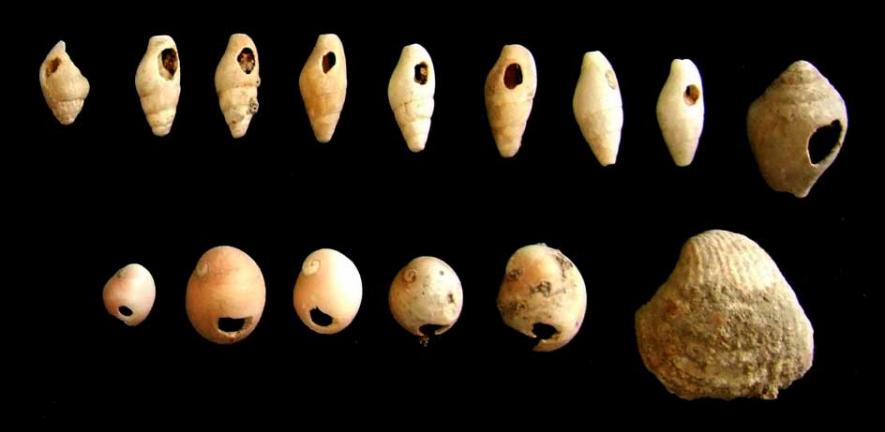
Excavation of 19,000-year-old hunter-gatherer remains, including a vast camp site, is fuelling a reinterpretation of the greatest fundamental shift in human civilisation – the origins of agriculture.
Excavation of 19,000-year-old hunter-gatherer remains, including a vast camp site, is fuelling a reinterpretation of the greatest fundamental shift in human civilisation – the origins of agriculture.
Because these early hunter-gatherers have been perceived as building only transient camp sites, they have been largely disregarded in explanations of the development of agriculture.
Dr Jay Stock
The moment when the hunter-gatherers laid down their spears and began farming around 11,000 years ago is often interpreted as one of the most rapid and significant transitions in human history – the ‘Neolithic Revolution’.
By producing and storing food, Homo sapiens both mastered the natural world and took the first significant steps towards thousands of years of runaway technological development. The advent of specialist craftsmen, an increase in fertility and the construction of permanent architecture are just some of the profound changes that followed.
Of course, the transition to agriculture was far from rapid. The period around 14,500 years ago has been regarded as the point at which the first indications appear of cultural change associated with agriculture: the exploitation of wild grains and the construction of stone buildings. Farming is believed to have begun in what is known as the Fertile Crescent in the Levant region, which stretches from northern Egypt through Israel and Jordan to the shores of the Persian Gulf, and then occurred independently in other regions of the world at different times from 11,000 years ago.
Recent evidence, however, has suggested that the first stirrings of the revolution began even earlier, perhaps as far back as 19,000 years ago. Stimulating this reinterpretation of human prehistory are discoveries by the Epipalaeolithic Foragers in Azraq Project (EFAP), a group of archaeologists and bioarchaeologists working in the Jordanian desert comprising University of Cambridge’s Dr Jay Stock, Dr Lisa Maher (University of California, Berkeley) and Dr Tobias Richter (University of Copenhagen).
Over the past four years, their research has uncovered dramatic evidence of changes in the behaviour of hunter-gatherers that casts new light on agriculture’s origins, as Dr Stock described: “Our work suggests that these hunter-gatherer communities were starting to congregate in large numbers in specific places, build architecture and show more-complex ritual and symbolic burial practices – signs of a greater attachment to a location and a changing pattern of social complexity that imply they were on the trajectory toward agriculture.”
Fertile Crescent
Working at the fringes of the Fertile Crescent, at sites in the Azraq Basin and the marshlands of Jordan, the EFAP team is excavating the archaeological remains of the hunter-gatherers who occupied the region. Such sites have been under studied, said Dr Stock: “Because these early hunter-gatherers have been perceived as building only transient camp sites, they have been largely disregarded in explanations of the development of agriculture. Instead, excavations have focused on the later ‘Natufian’ period, beginning around 14,500 years ago, since this period more clearly shows cultural precursors of the transition to agriculture.”
Today, the Azraq Basin is a 12,000 sq km area of dusty, wind-blown desert, and a very challenging place to work. Temperatures can soar to 45°C, requiring the researchers to start field work at 5 am and finish by midday when the heat and winds become too strong to allow work to continue.
But when the first humans were leaving Africa, the open grasslands and lush marshlands of the Fertile Crescent teemed with gazelle, antelope and plant life. Given this region is situated at the crossroads between Africa and the rest of the world, it is perhaps unsurprising that it should be the site of regional agricultural innovation.
Few previous archaeological excavations have been carried out in this inhospitable terrain, most instead focusing on regions closer to the Mediterranean. With funding from the Arts and Humanities Research Council, the researchers set out four years ago to redress the balance.
Complex burials
Dr Stock’s expertise lies in the analysis of hunter-gatherer bones. Over the past 15 years, he has analysed over 1,400 skeletons from around the world to understand what it is about early humans that made them such successful colonisers of the natural environment.
One of the most startling of the researchers’ findings in Jordan has been the hunter-gatherer graves. Evidence suggests that, far from simple burials, the hunter-gatherers had elaborate mortuary and sociocultural practices. In one grave in ʻAyn Qasiyya, an adult male was placed in marshland in a sitting position, and was likely to have been tightly wrapped in cloth. A previous finding by another archaeologist at Kharaneh IV was a burial of an older man underneath a hut floor, his age suggesting that he would have required the care of others in life.
At another site, ‘Uyun-al-Hammam, a University of Toronto-based project led by Dr Maher has excavated a total of 11 burials, some of which show elaborate mortuary treatments. Indeed, one grave that includes a human buried together with a fox, said Dr Maher: “suggests a close emotional or symbolic tie between humans and foxes prior to the first domesticated animal – the dog – and shows continuity in burial and social practices with the later Neolithic”. Dr Stock’s study of the human remains demonstrates that these people were ancestral to the later farmers.
The researchers argue that these examples may represent an increasing cultural sophistication and a greater complexity in the relationship between humans and animals – trends that had only previously been identified in later time periods.
Mega camp site
A major focus of the work of the EFAP team over the past four years has been the excavation of the site of Kharaneh IV, in the Azraq Desert of eastern Jordan. The site is much more than the sort of temporary camp site normally ascribed to hunter-gatherer groups. Covering almost two hectares, the 19,000-year-old site was occupied for 1,200 years and is, as Dr Stock described, “so huge, it’s the earliest sign of human activity that is large enough to be visible on Google Earth.”
“To produce the debris of stone tools and bones, in some places almost 3 m deep, we believe that many groups of hunter-gatherers would meet and live together for several months of the year before splitting into mobile groups at other times.”
The team is researching the area in astonishing detail – in a technique known as 100% flotation, every square centimetre excavated is floated to check for plant remains and charcoal. As Dr Richter pointed out: “even very small remains are providing very important clues towards our understanding of the relationship between prehistoric humans and their habitat”.
To date, they have found plant remains, animal bones carved with repeated incised motifs, stones carved with geometric patterns, stone tools in their thousands, hearths, pierced shells and, just recently, oval hut structures. As the work continues, all indications point towards an advanced cultural and technological complexity in the exploitation of bone, shell, plants and architecture. “The size of the site, combined with evidence for huts and other symbolic goods, imply that Kharaneh IV was long-term and repeatedly occupied,” said Dr Stock. “It could be regarded as a precursor to later farming villages.”
The revolution that wasn’t
The team’s discoveries extend many aspects of the behavioural complexity associated with the Neolithic to about 10,000 years earlier, pushing back the true roots of the transition to agriculture.
“On evolutionary timescales, the transition to agriculture can undoubtedly be regarded in revolutionary terms,” said Dr Stock. “But, we can now see this as a culturally dynamic process that began much earlier than previously thought.”
“This picture would not have come together through the excavation of one site alone,” he added. “The burial complexity of ʻUyun-al-Hammam and ʻAyn Qasiyya, together with the architecture and size of the settlement at Kharaneh IV, collectively offer glimpses of a protracted period in which humans worked through the cultural and biological changes that needed to happen before village life and the systematic exploitation of grain could emerge.”
This work is licensed under a Creative Commons Licence. If you use this content on your site please link back to this page.





